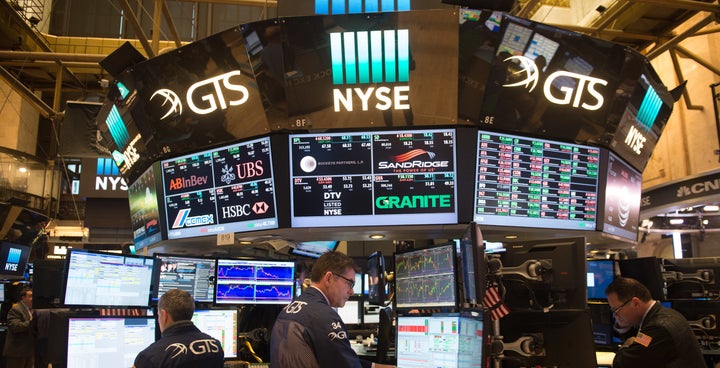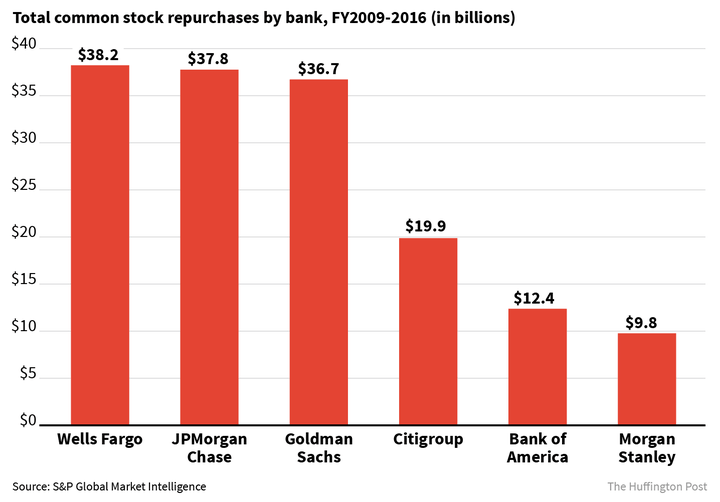
The CEO of America’s largest bank made a startling announcement last week: His company has too much money, and he plans to throw away its profits on rich people.
He didn’t quite put it that way, of course. In his annual letter to shareholders, JPMorgan Chase CEO Jamie Dimon boasted about his company buying $25.7 billion of its own stock over the past five years, and hinted it could buy back another “big block of stock this year” to further boost share prices.
At their best, stock buybacks (also known as “share repurchases”) are essentially pointless. At their worst, buybacks drain resources from productive economic activity to provide a cheap high for Wall Street. Companies buy their own stock to raise the stock price: Removing shares from the market elevates the value of those that remain. Money is funneled from corporate coffers to shareholders.
Companies could, of course, do other things with their profits. They could raise pay for their employees or provide better benefits. They could develop new product ideas or upgrade old equipment to improve future production. The point of a company, after all, is not simply to generate and distribute cash, but to solve problems for society, or at least invent cool stuff that makes life more interesting and fun. This doesn’t have to be altruistic ― inventing awesome stuff raises stock prices when the awesome stuff sells.
Buybacks overwhelmingly benefit rich people. Less than 22 percent of Americans own $25,000 or more in stock, even through retirement accounts, according to research from New York University economist Edward N. Wolff. Those who own lots of stock are heavily concentrated at the top. More than 92.8 percent of households making at least $250,000 a year own at least $10,000 in stock, compared with just 19.1 percent of households earning between $25,000 and $49,999. Households in the top 1 percent receive an average of 36 percent of their income from capital gains (stocks, bonds and other financial investments), according to the Congressional Budget Office, while those in the lowest 20 percent receive an average of about 5 percent of their income this way.
Some of the wealthy people who benefit most from buybacks are corporate CEOs, who generally receive most of their compensation in stock.

To fuel the economy, banks don’t have to make or invent anything that people use. They just have to extend financing to people who want to make stuff, or to people who want to buy it. This isn’t charity ― banks earn big profits by lending.
But sometimes they’d rather just buy their own stock. Since the financial crisis, the nation’s six largest banks have spent a combined $157.4 billion buying up their own stock, according to data from S&P Global Market Intelligence. JPMorgan, Goldman Sachs and Wells Fargo have spent over $36 billion each. All six of those banks declined to comment for this article.
Defenders of stock buybacks argue they can be a useful corporate strategy in a weak economy. If companies can’t find a market for their products, then placating investors through buybacks isn’t a terrible use of funds until the economy turns up. Big Bank buybacks don’t fit that pattern ― they’ve expanded tremendously during the last five years of economic recovery, nearly quadrupling from $10.6 billion in 2012 to $41.9 billion in 2016.

Dimon’s annual missives aren’t really for his shareholders ― they’re public political statements from America’s most prominent banker. In the latest edition, he noted that trillions of dollars in war spending, mass incarceration and the student debt explosion have damaged the economy. But while he didn’t offer specific policy remedies for those political problems, he did make recommendations on economic policy, arguing that excessive capital and liquidity regulations are tying up money his bank could deploy to put people to work.
Dimon called for weakening these rules, which require banks to rely on less debt and hold more cash in case of trouble. Maybe it’s true that not one dollar of the more than $9 billion JPMorgan spent on buybacks in 2016 could have gone toward making a good loan to a creditworthy business. But if so, weakening capital and liquidity rules won’t help banks get more money out the door ― the economy is just out of good lending opportunities. In that scenario, JPMorgan would have nothing productive to do with the money freed up by weakening capital and liquidity rules. The broader economy would be shouldering more risk in order to further enrich wealthy bank shareholders without seeing any increase in lending.
Big banks have a history of being reckless with buybacks. Citibank swallowed up over $7.5 billion of its own stock in 2006 and 2007, before it needed a government bailout, as University of Massachusetts Lowell economics professor William Lazonick noted in 2008. Morgan Stanley spent over $7 billion on buybacks over the same period before it too needed to be bailed out. Bear Stearns spent $6 billion before needing a government-backed rescue from JPMorgan. Lehman Brothers spent over $5 billion before missing the bailout train and going bankrupt.
It’s one more way Wall Street fuels economic inequality.
Zach Carter is a co-host of the HuffPost Politics podcast “So That Happened.” Listen to the latest episode, embedded below:
To listen to this podcast later, download the show on iTunes. You can also find it on Google Play Music, RadioPublic, or Acast.
